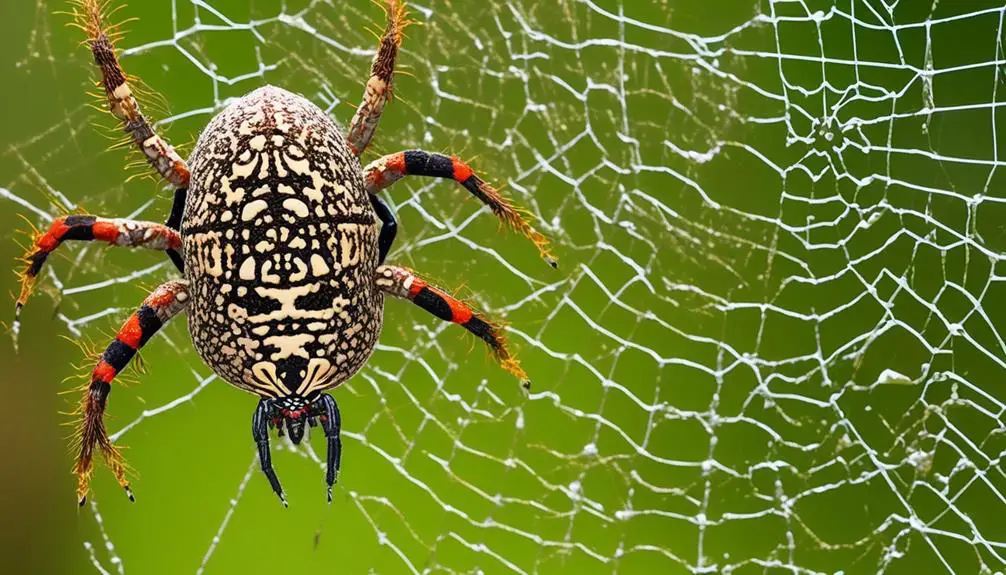Did you know that Bali is home to over 700 species of spiders? That’s right, this tropical paradise is teeming with these fascinating arachnids.
But before you start imagining giant, venomous spiders lurking around every corner, let’s take a closer look at the common species you might encounter during your stay. From the elusive Huntsman Spider to the intricately patterned Golden Orb-Weaver, each spider has its own unique characteristics and behaviors.
So, whether you’re planning a hike through the lush jungles or simply relaxing on the beach, it’s important to be aware of the spiders that may cross your path.
Let’s dive into the world of spiders in Bali and discover which species you should watch out for.
Huntsman Spider
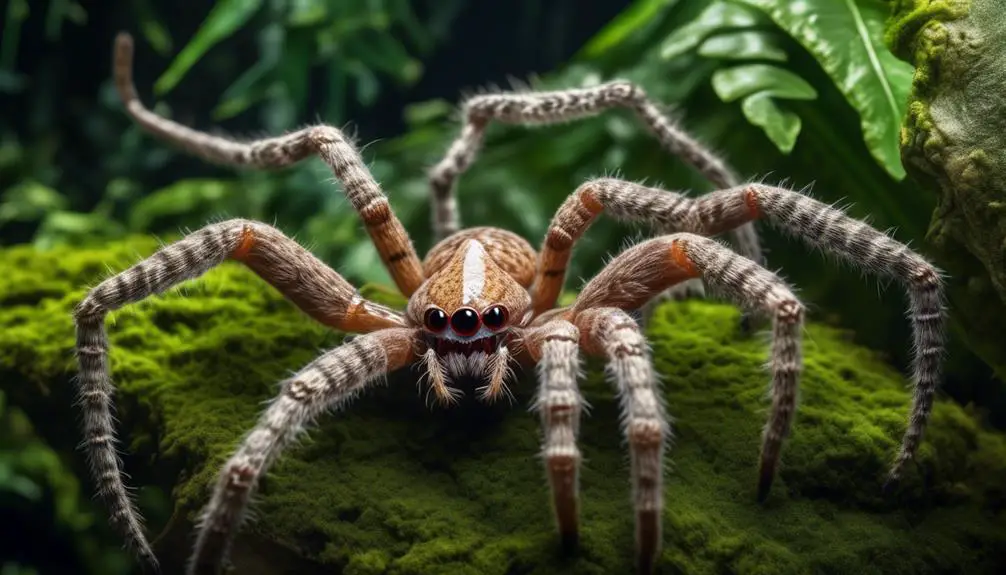
The Huntsman spider, known scientifically as Heteropoda maxima, is a large arachnid commonly found in wooded areas of Bali. This species can grow up to 15 centimeters in leg-span, making it one of the largest spiders in the region. With its long, slender legs and flattened body, the Huntsman spider possesses a unique appearance that sets it apart from other spider species.
Despite its intimidating size, the Huntsman spider is mostly harmless to humans. However, if threatened or provoked, it can deliver a nasty bite. It’s important to exercise caution when encountering these spiders in their natural habitat. The bite of a Huntsman spider may cause localized pain, swelling, and redness.
Huntsman spiders are skilled hunters, relying on their excellent vision and agility to capture prey. They primarily feed on insects, small arthropods, and even other spiders. These spiders are known for their ability to climb walls and ceilings, thanks to the specialized hairs on their legs that allow them to grip onto surfaces.
Golden Orb-Weaver
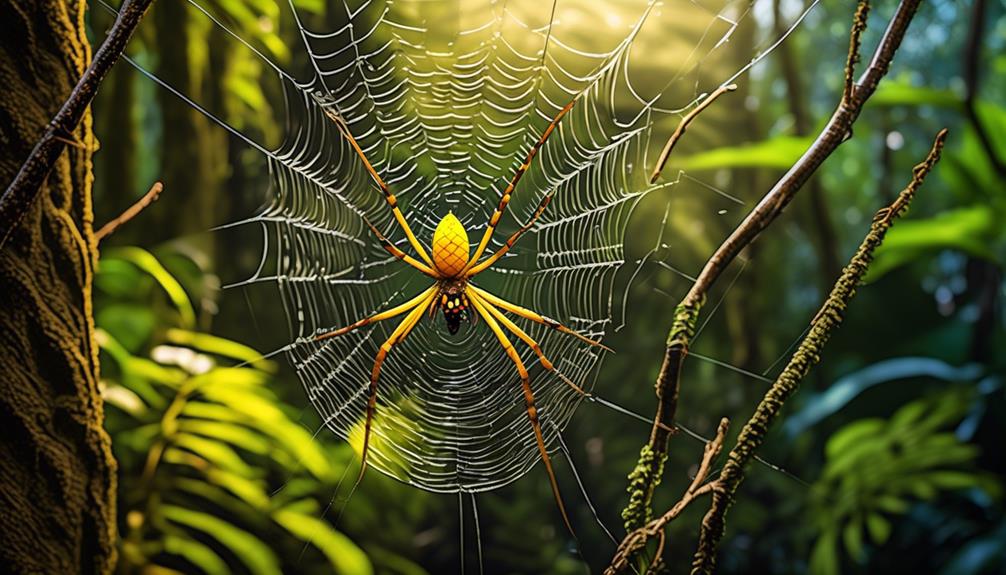
Now, let’s talk about the Golden Orb-Weaver, a fascinating spider species found in Bali.
Known for its impressive size, the Golden Orb-Weaver can grow up to 20 centimeters in size.
Its vibrant yellow webs, spun between tree branches, are a sight to behold.
Despite its intimidating appearance, this spider is non-venomous and harmless to humans, making it a captivating creature to observe in its natural habitat.
Size and Appearance
Growing up to 20 centimeters in size, the Golden Orb-Weaver spider in Bali is known for its impressive stature and intricate web-spinning abilities.
This species showcases a distinctive appearance with a round, bulbous abdomen that can reach up to 3 centimeters in diameter. The females are larger than the males, featuring a vibrant golden hue on their bodies and legs, which helps them camouflage among the trees and foliage.
Their webs are equally remarkable, spanning up to 1.5 meters in diameter. The silk they produce is incredibly strong and sticky, allowing them to capture prey as large as small birds and bats.
Despite their intimidating size, Golden Orb-Weavers are non-venomous and pose no threat to humans.
Web-spinning Behavior
After exploring the size and appearance of the Golden Orb-Weaver spider in Bali, let’s now delve into its fascinating web-spinning behavior.
The Golden Orb-Weaver is renowned for its impressive ability to spin large, intricate webs. These webs are typically suspended between tree branches and can reach sizes of up to one meter in diameter. The silk threads produced by the spider are incredibly strong and can withstand considerable force from prey that becomes entangled.
The purpose of these webs is to capture flying insects, which the spider feeds on. The silk of the Golden Orb-Weaver is also known for its golden color, which helps camouflage the web and adds to its aesthetic appeal.
Observing this web-spinning behavior can be a captivating experience, revealing the intricate skills and adaptations of this fascinating spider species.
Non-venomous and Harmless
The Golden Orb-Weaver spider in Bali is a non-venomous and harmless species that poses no threat to humans. These spiders are known for their impressive size, with some individuals growing up to 20 centimeters in size. They’re easily recognizable by their vibrant yellow coloration and their ability to spin large yellow webs between tree branches.
Despite their intimidating appearance, Golden Orb-Weavers aren’t aggressive towards humans and will only bite if they feel threatened. However, their bites are harmless and rarely cause any significant reaction in humans. It’s important to note that these spiders play a crucial role in controlling the population of insects and other pests in their environment.
If you come across a Golden Orb-Weaver spider in Bali, there’s no need to panic. Simply admire its beauty from a safe distance and appreciate the important role it plays in the ecosystem.
Jumping Spider
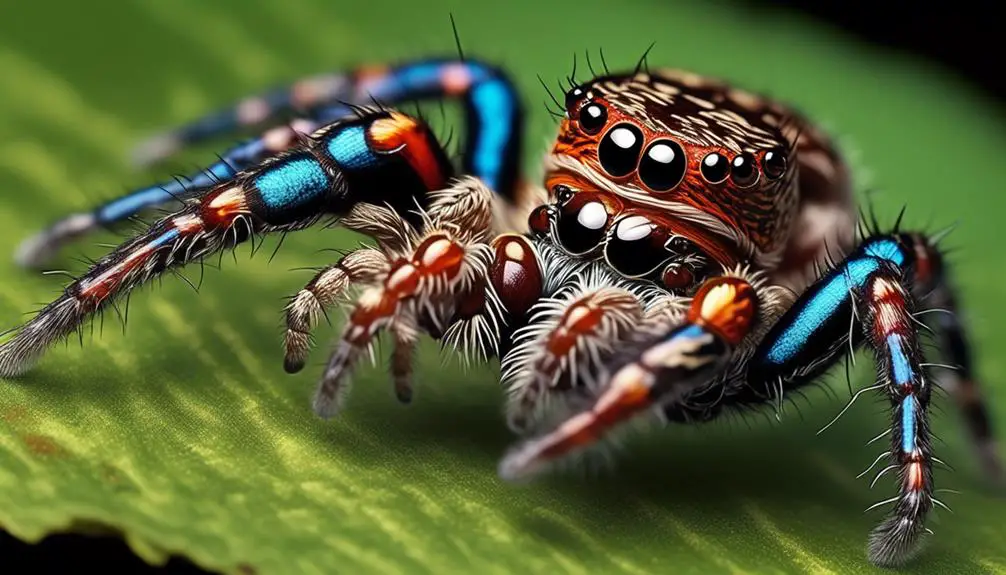
Get ready to be amazed by the jumping spider’s impressive leaping abilities and its striking variety of body shapes and patterns.
These agile arachnids are known for their ability to leap on prey and quickly flee from danger. With their eight eyes and countless species, jumping spiders are a fascinating and diverse group.
They add to the rich spider population in Bali.
Impressive Leaping Abilities
With their remarkable leaping abilities, Jumping Spiders in Bali possess a unique and fascinating method of hunting and escaping from potential threats. These agile arachnids are known for their ability to jump impressive distances, often many times their own body length. What sets them apart from other spiders is their highly specialized eyes, which provide them with exceptional vision and depth perception.
Jumping Spiders use this visual acuity to accurately judge the distance and trajectory of their leap, enabling them to pounce on unsuspecting prey with great precision. Their exceptional jumping skills also serve as a means of escape, allowing them to quickly evade predators or potential dangers.
This remarkable ability, combined with their keen hunting instincts, makes Jumping Spiders in Bali formidable and captivating creatures to observe.
Varied Body Shapes and Patterns
Jumping spiders in Bali exhibit a wide range of body shapes and patterns, showcasing their remarkable diversity and adaptability. These small, agile spiders have compact bodies with short legs, allowing them to make precise leaps to catch their prey.
Their bodies can vary in color, ranging from vibrant green or red to shades of brown or black, often adorned with intricate patterns and markings. These patterns serve various purposes, such as camouflage to blend in with their surroundings or to attract potential mates. Some jumping spiders even have iridescent scales that create a dazzling display when caught in sunlight.
The ability of jumping spiders to adapt their body shapes and patterns to different environments is a testament to their evolutionary success in Bali.
Wolf Spider
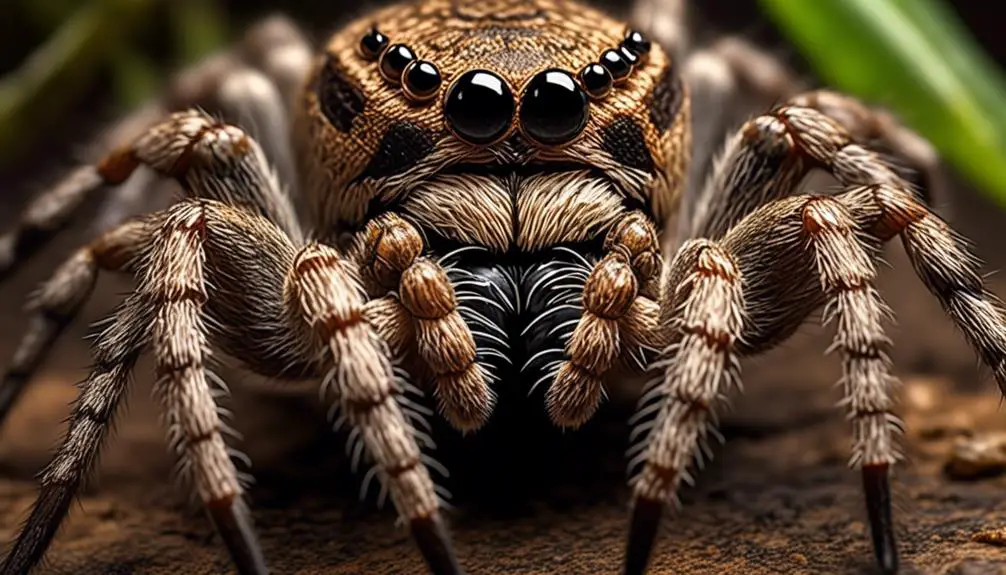
The Wolf Spider, a common spider species in Bali, is known for its long legs and dark coloring. These spiders belong to the Hogna aspersa species and are predominantly nocturnal. They can be found in various habitats, including forests, gardens, and even inside homes.
Wolf spiders aren’t aggressive and generally avoid human contact. They’re skilled hunters, relying on keen eyesight to locate and ambush their prey. With their strong legs, they can pounce on their victims, immobilizing them with their venomous bite. However, their bites are relatively harmless to humans, causing little more than swelling, itching, and mild pain. The venom of the Wolf Spider isn’t considered medically significant.
These spiders play an important role in controlling the population of insects and other pests. When encountered, it’s best to observe them from a safe distance and appreciate their fascinating behavior and natural beauty.
Anelosimus bali
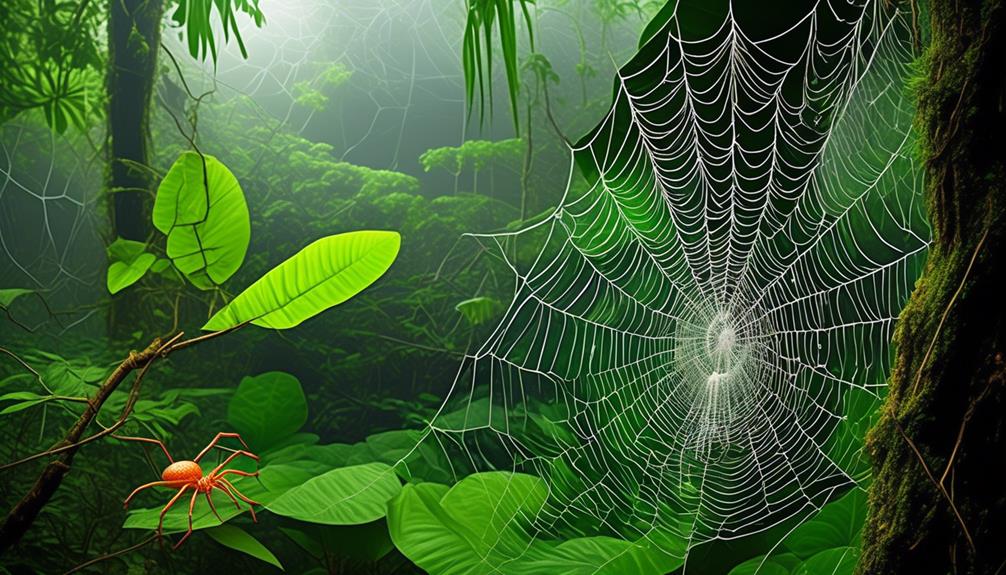
Anelosimus bali, a tiny spider endemic to Bali, is primarily found in trees along coastal regions and mangroves. This species, also known as the Bali social orb-weaver, is believed to live in solitary isolation. With its delicate frame and intricate web-spinning abilities, Anelosimus Bali is a fascinating creature to observe in its natural habitat.
Let’s take a closer look at the characteristics of Anelosimus Bali in the table below:
| Characteristics | Description |
|---|---|
| Size | Small |
| Habitat | Trees along coastal regions and mangroves |
| Social Behavior | Solitary |
Anelosimus bali small size allows it to blend seamlessly into its surroundings, making it difficult to spot. Its preferred habitat in the trees along coastal regions and mangroves provides the perfect environment for hunting and building its intricate webs.
Although Anelosimus bali is not considered dangerous to humans, it is important to exercise caution and avoid disturbing their webs or getting too close. By appreciating the beauty and uniqueness of this species from a safe distance, we can contribute to the preservation of Bali’s diverse spider population.
Tree Trunk Spiders
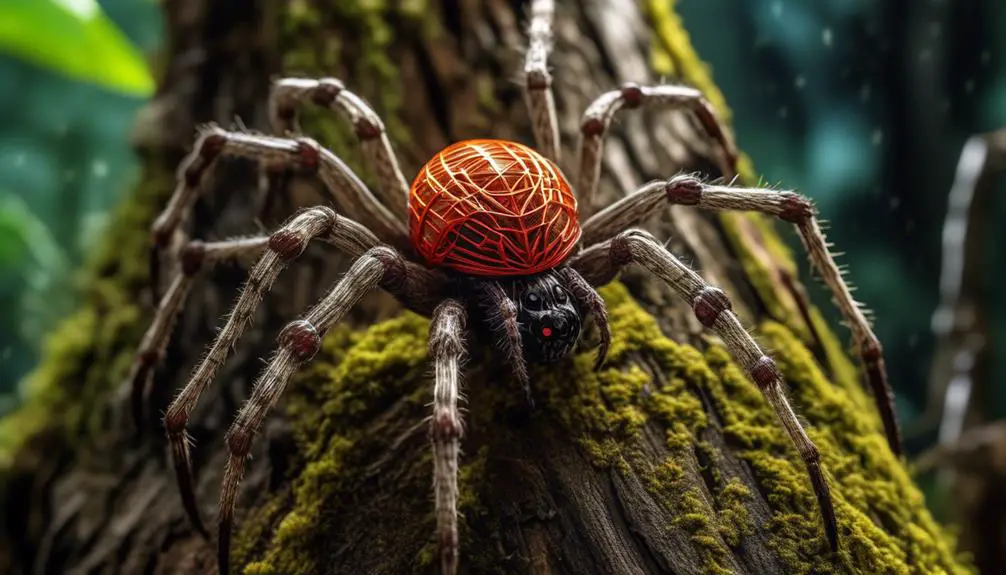
Tree trunk spiders, commonly found in Bali, are known for their small bodies and long protruding legs, which they use to trap prey by laying webbing over patches of trees. These spiders belong to the species Herennia multipuncta and are prevalent in the forests of Bali. They’ve a unique adaptation that enables them to camouflage themselves against the bark of trees, making them difficult to spot. Their small size allows them to navigate through the crevices and gaps on tree trunks with ease.
These spiders are skilled web builders and construct intricate webs that serve as effective traps for unsuspecting insects. Once an insect comes into contact with the web, the tree trunk spider quickly immobilizes it by wrapping it in silk. They then inject venom into their prey to begin the digestion process. They primarily feed on small insects like flies, ants, and beetles that venture onto the tree trunks.
Tree trunk spiders in Bali play an essential role in maintaining ecological balance by controlling insect populations. Their ability to camouflage and construct efficient webs showcases their remarkable adaptations to their environment.
Belisana
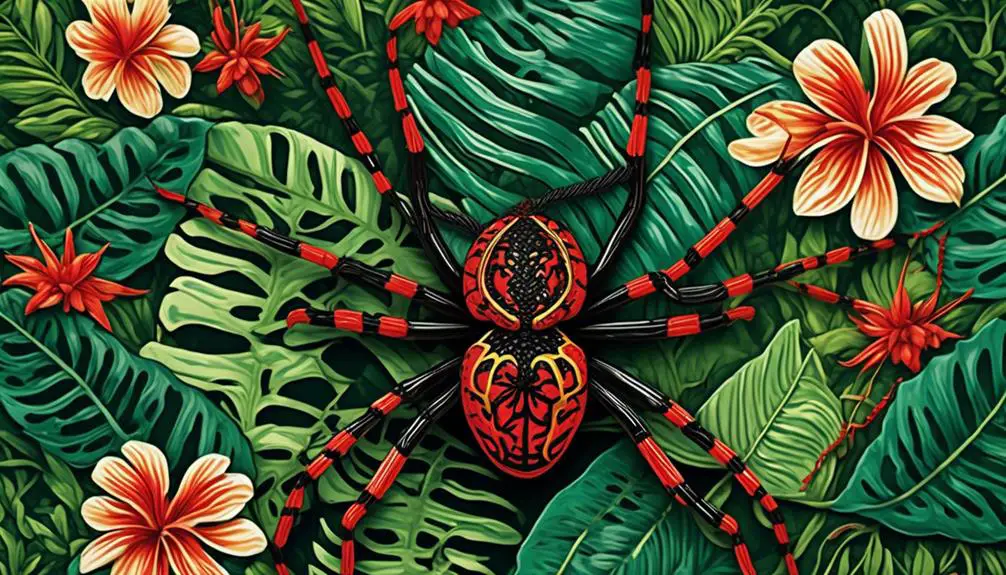
Belisana, a spider species found in Bali, is completely harmless to humans and belongs to the same group as daddy long legs. These spiders are characterized by their small bodies and long, thin legs. Belisana spiders are skilled web builders, using their silk to create intricate structures that serve as traps for their prey. They typically wrap their captured prey with additional webbing to immobilize them. Belisana spiders are commonly found in gardens, forests, and other natural habitats throughout Bali.
Despite their intimidating appearance, Belisana spiders pose no threat to humans. They don’t possess venom glands and aren’t capable of biting or causing any harm. These spiders primarily feed on small insects and other arthropods, contributing to the natural control of pest populations. Their presence in the ecosystem is beneficial, as they help maintain the balance of the local insect community.
If you come across a Belisana spider, there’s no need for concern. They’ll not bite or attack unless provoked, and even then, their bite would be completely harmless. So, take a moment to appreciate these fascinating creatures and the important role they play in the environment.
Venomous Spiders
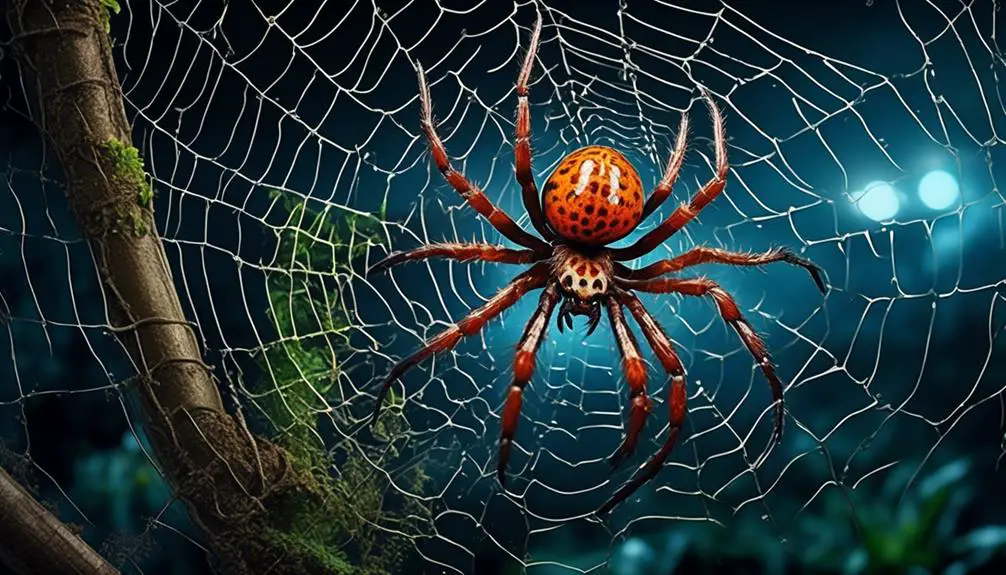
Bali is home to several venomous spider species that should be approached with caution. While most spiders in Bali are harmless, there are a few species that possess venom that can cause harm to humans. One such species is the Redback Spider, known for its venomous bite and distinctive red marking. Although its bite generally causes minor irritation and swelling, it’s still important to exercise caution when encountering this spider.
Another venomous spider to be aware of is the Black Widow Spider, although it’s rarely found in Bali. Its bite can be harmful and may cause severe symptoms in some individuals. The Brown Widow Spider is also present in Bali, but it’s less venomous than its black counterpart.
The Funnel-web Spider is another highly venomous species known for its aggressive behavior. Although encounters with this spider are rare, it’s important to exercise extreme caution if you come across one. The Mouse Spider, while less venomous, can still deliver a painful bite if provoked.
If you’re bitten by a venomous spider, symptoms may include localized pain, swelling, itchiness, and redness. In rare cases, individuals may experience severe allergic reactions. First aid for a spider bite includes cleaning the bite area with soap and water, applying a cold compress to reduce swelling, and seeking medical attention if necessary. In severe cases, specific antivenom may be administered.
To prevent spider bites, it’s important to regularly clean and remove clutter to eliminate spider hiding spots. Sealing cracks and gaps in windows, doors, and walls can also prevent spiders from entering your living space. Additionally, eliminating insects and other small prey that spiders feed on can help reduce the spider population. Using natural repellents, such as certain plants and essential oils, can also be effective in keeping spiders at bay. If you have a severe infestation, it’s advisable to seek help from a professional pest control service.
Spider Bite Symptoms and Treatment
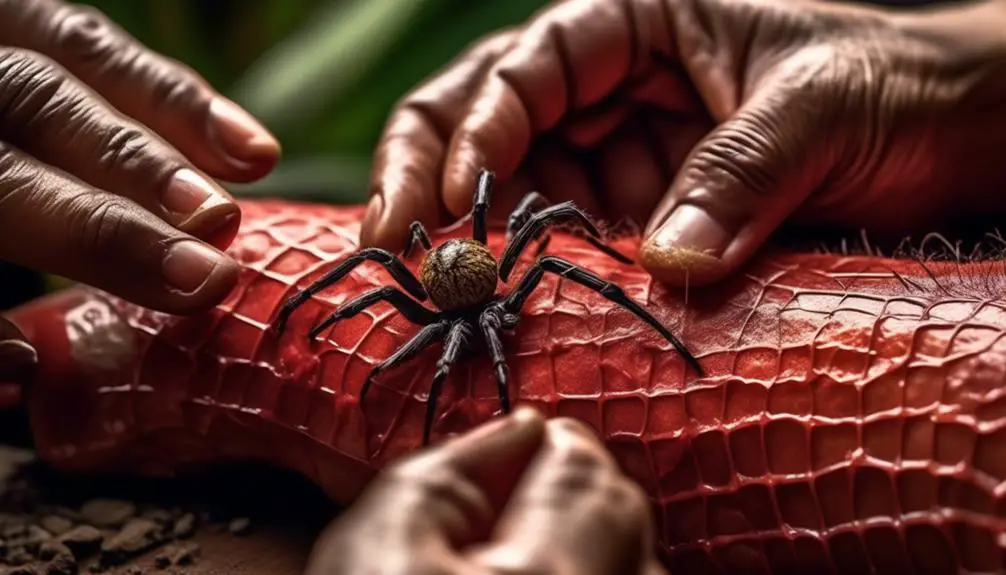
If you’re bitten by a venomous spider in Bali, it’s important to recognize the symptoms and seek appropriate treatment as soon as possible.
Spider bites can cause localized pain, swelling, itchiness, and redness. In rare cases, individuals may experience severe allergic reactions.
First aid for spider bites includes cleaning the bite area with soap and water to prevent infection. Applying a cold compress can help reduce pain and swelling.
If necessary, seek medical attention for further evaluation and treatment. In some cases, specific antivenom may be administered for severe spider bites.
It’s crucial to provide accurate information about the spider species involved in the bite to healthcare professionals for appropriate treatment. Remember, not all spider bites are venomous, but it’s better to err on the side of caution and seek medical advice.
Prompt recognition of symptoms and proper treatment can help prevent complications and ensure a speedy recovery.

Erzsebet Frey (Eli Frey) is an ecologist and online entrepreneur with a Master of Science in Ecology from the University of Belgrade. Originally from Serbia, she has lived in Sri Lanka since 2017. Eli has worked internationally in countries like Oman, Brazil, Germany, and Sri Lanka. In 2018, she expanded into SEO and blogging, completing courses from UC Davis and Edinburgh. Eli has founded multiple websites focused on biology, ecology, environmental science, sustainable and simple living, and outdoor activities. She enjoys creating nature and simple living videos on YouTube and participates in speleology, diving, and hiking.

